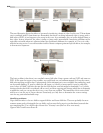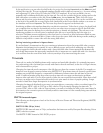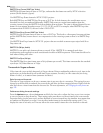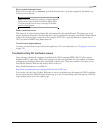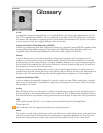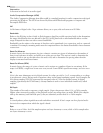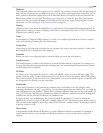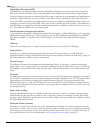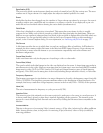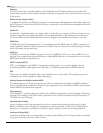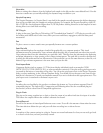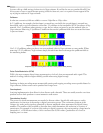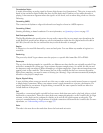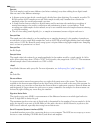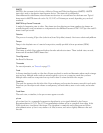
380
GLOSSARY APPENDIX B
Digital Signal Processing (DSP)
A general term describing anything that alters digital data. Signal processors have existed for a very long
time (tone controls, distortion boxes, wah-wah pedals) in the analog (electrical) domain. Digital Signal
Processors alter the data after it has been digitized by using a combination of programming and mathematical
techniques. DSP techniques are used to perform many effects such as equalization and reverb simulation.
Since most DSP is performed with simple arithmetic operations (additions and multiplications), both your
computer’s processor and specialized DSP chips can be used to perform any DSP operation. The difference is
that DSP chips are optimized specifically for mathematical functions while your computer’s microprocessor is
not. This results in a difference in processing speed.
DirectX Application Programming Interface
A set of interfaces designed by Microsoft for multimedia development. A DirectX® plug-in, such as the Sony
Media Software Noise Reduction™ DirectX plug-in, uses the DirectX Media Streaming Services (DMSS)
API. Because DMSS is a standard API, a DirectX plug-in can be used in any application that supports
DMSS.
Dithering
The practice of adding noise to a signal to mask quantization noise (see also Noise Shaping).
Drag and Drop
A quick way to perform certain operations using the mouse. To drag and drop, you click and hold a
highlighted selection, drag it (hold the left-mouse button down and move the mouse) and drop it (let go of
the mouse button) at another position on the screen.
Dynamic Range
The difference between the maximum and minimum signal levels. It can refer to a musical performance
(high volume vs. low volume signals) or to electrical equipment (peak level before distortion vs. noise floor).
For example, orchestral music has a wide dynamic range, while thrash metal has a very small (always loud)
range.
Emphasis
A rudimentary noise reduction process that involves a boost in the high frequencies during the recording of
the CD and a complimentary cut in the same frequencies during the playback of the CD. The result reduces
high frequency noise without disrupting the natural frequency response of the source material. If the
emphasis flag is set for a track, any CD player that has a de-emphasis circuit will impart the high frequency
cut on the track. Be aware that Vegas software cannot impart the pre-emphasis boost on a track; it can only
set the emphasis flag.
Endian (Little and Big)
Little and Big Endian describe the ordering of multi-byte data that is used by a computer’s microprocessor.
Little Endian specifies that data is stored in a low to high-byte format; this ordering is used by the Intel®
microprocessors. Big Endian specifies that data is stored in a high to low-byte format; this ordering is used by
the Motorola® microprocessors.
Envelopes (Audio and Video)
Envelopes, as used by Vegas software, are a way of automating the change of a certain parameter over time.
In the case of volume, you can create a fade out (which requires a change over time) by adding an envelope
and creating an extra point to the line that indicates where the fade starts. Next, you pull the end point of
the envelope down to -inf. For more information, see Working with track envelopes on page 163.



